Delay is an effect that has shaped the sound of guitar music across genres, from the subtle thickening of tone to expansive, otherworldly soundscapes. It’s no exaggeration to say that a delay pedal is an essential tool for almost any guitarist. Whether you’re aiming for the atmospheric washes of U2, the rhythmic complexity of Radiohead, or the soaring leads of Guns N’ Roses, understanding and utilizing delay is key. This guide dives into the world of the Best Delay Guitar pedals, helping you discover the perfect echo companion for your sound.
From adding just a touch of depth to making your guitar sing with spacious repeats, delay pedals offer incredible versatility. They can soften the sometimes harsh attack of lead notes, create rhythmic textures, and even emulate the spaciousness of a large room. With so many options available, finding the right delay pedal can feel overwhelming. That’s why we’ve compiled this guide to the top contenders, covering a range of styles, features, and budgets to help you find your ideal delay.
Our Top Picks
 Line 6 DL4 MkII delay pedal
Line 6 DL4 MkII delay pedal
Best overall: Line 6 DL4 MkII
 Boss DD-3T delay pedal
Boss DD-3T delay pedal
Best digital: Boss DD-3T Delay
 Boss RE-202 Space Echo delay pedal
Boss RE-202 Space Echo delay pedal
Best tape delay: Boss RE-202 Space Echo
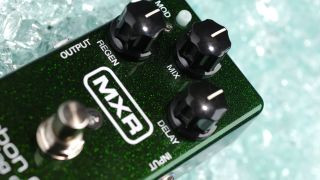 MXR Carbon Copy delay pedal controls
MXR Carbon Copy delay pedal controls
Best analog delay: MXR Carbon Copy
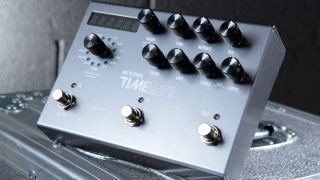 Strymon Timeline delay pedal on a flight case
Strymon Timeline delay pedal on a flight case
Best for gigging: Strymon Timeline
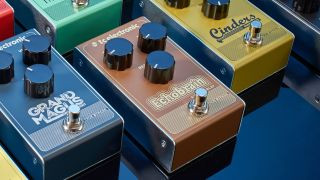 TC Electronic Echobrain delay pedal
TC Electronic Echobrain delay pedal
Best budget option: TC Electronic Echobrain
Best overall
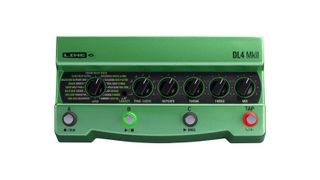 Line 6 DL4 MKII delay pedal angled view
Line 6 DL4 MKII delay pedal angled view
(Image credit: Line 6)
1. Line 6 DL4 MKII
A modern upgrade to a delay classic, offering a vast palette of sounds.
Our expert review:
Specifications
| Feature | Detail |
|---|---|
| Type | Digital delay |
| Bypass | Buffered |
| Tap-tempo | Yes |
| Modes/patches | 30 |
Reasons to buy
- Exceptional sound quality and versatile reverb effects.
- Compact and redesigned chassis for pedalboard friendliness.
- Expanded looping capabilities for creative exploration.
- User-friendly interface for easy sound manipulation.
Reasons to avoid
- Might be feature-rich overkill for players seeking simple delay.
At a glance
✅ Buy if you want the ultimate selection of delays: The DL4 MkII is packed with a comprehensive collection of delay tones, alongside a suite of high-quality reverb effects, making it a powerhouse of classic and modern delay sounds.
❌ Avoid if you want simplicity: If you prefer a straightforward delay with fewer options, the DL4 MkII’s extensive features might be more than you need.
The original Line 6 DL4 is a landmark pedal that defined the sound of a generation. Released in the early 2000s, it shifted perceptions of digital stompboxes and revolutionized the pedal landscape. Now, the Line 6 DL4 MKII emerges as a worthy successor, retaining the magic of the original while enhancing its capabilities for today’s guitarist.
This updated and more compact unit delivers the beloved classic DL4 delays with significant enhancements. The DL4 MkII boasts 15 new MKII delay algorithms alongside the original 15 Legacy DL4 sounds. Furthermore, it features expanded internal memory, now offering 120 seconds of mono or 60 seconds of stereo looping time. Adding to its versatility, Line 6 has included a selection of high-quality reverb algorithms, effectively making the DL4 MKII a three-in-one powerhouse.
EXPERT VERDICT: LINE 6 DL4 MKII
EXPERT VERDICT: LINE 6 DL4 MKII – Paul Riario
“Line 6 deserves praise for preserving the intuitive nature and broad appeal of the original DL4 in the MkII. The sheer joy of tweaking knobs and stomping footswitches unlocks a vast spectrum of delay textures, all without the complexity of LED screens or menu navigation.”
Read more: Line 6 DL4 MKII review
Best digital delay
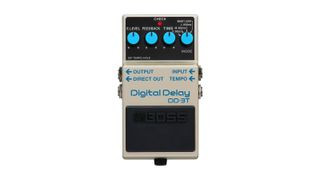 Boss DD-3T digital delay pedal front view
Boss DD-3T digital delay pedal front view
(Image credit: Boss)
2. Boss DD-3T
The iconic digital delay pedal, refined for modern players, remains a top choice.
Our expert review:
Specifications
| Feature | Detail |
|---|---|
| Type | Digital delay |
| Bypass | Buffered |
| Tap-tempo | Yes |
| Modes/patches | 4 |
Reasons to buy
- Modern iteration of a legendary delay pedal.
- Delivers pristine, crystal-clear digital delays.
- Added tap-tempo input for tempo synchronization.
Reasons to avoid
- For a slightly higher price, the DD-8 offers more features.
At a glance
✅ Buy if you want simple digital delay tones: The DD-3T, a favorite amongst professional guitarists, offers classic, pristine digital delay tones with added tap tempo functionality and improved output jack placement for ease of use.
❌ Avoid if you want lots of choice: While the DD-3T excels at its core sound, it offers limited tonal variety. Consider other options if you need a wider range of delay types.
The Boss DD-3 has been a cornerstone of digital delay for three decades, renowned for its exceptional sound quality. Its pristine delays, pleasing sonic character, and EQ profile make it ideal for diverse settings, from bedroom practice to professional studio recordings and live performances. It’s a reliable and versatile choice for guitarists of all levels.
The latest DD-3T update enhances its functionality with a tap-tempo input, enabling external tap tempo control for synchronizing delays with band tempos. Boss also relocated the direct output jack to the left side, improving pedalboard integration.
Beyond these updates, the DD-3T retains the core sound and layout of the original. It offers delay times in milliseconds with 50, 200, 800, and a short loop setting. The Level, Feedback, and Time knobs remain unchanged, staying true to the “if it ain’t broke…” philosophy. The Boss DD-3’s continued presence on pedalboards speaks to its enduring appeal and timeless sound.
EXPERT VERDICT: BOSS DD-3T
EXPERT VERDICT: BOSS DD-3T – Chris Gill
“The DD-3T delivers the same beloved sound quality that established the DD-2/DD-3 as a long-standing favorite among guitarists for over 37 years. With added features and a more sensible output jack configuration, the DD-3T is a worthy successor to the DD-3, poised to continue its legacy for years to come.”
Read more: Boss DD-3T review
Best tape delay
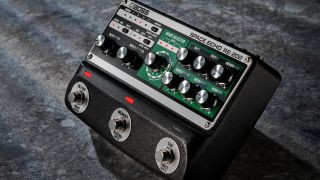 Boss RE-202 Space Echo pedal on floor closeup
Boss RE-202 Space Echo pedal on floor closeup
If you want vintage tones with modern usability, the RE-202 is the one (Image credit: Future)
3. Boss RE-202 Space Echo
A modern pedal capturing the magic of an iconic tape delay, blending vintage warmth with contemporary features.
Our expert review:
Specifications
| Feature | Detail |
|---|---|
| Type | Digital delay |
| Bypass | Buffered |
| Tap-tempo | Yes |
| Modes/patches | 12 echo, 5 reverbs |
Reasons to buy
- Authentic and highly accurate tape delay emulation.
- Wide range of tonal shaping options for diverse sounds.
- Expression pedal input for dynamic parameter control.
Reasons to avoid
- Some advanced features can be somewhat complex to access and adjust.
- Not ideal for pristine, clean digital delay sounds due to its vintage tape character.
At a glance
✅ Buy if you want iconic tape tails: The RE-202 delivers the coveted vintage tape delay sounds of the Roland RE-201 Space Echo in a modern, user-friendly pedal format.
❌ Avoid if you like modern sounds: If you prioritize pristine, transparent digital delays, the RE-202’s vintage-inspired, characterful tones might not be the best fit.
The Boss RE-202 Space Echo brings the legendary Roland RE-201 Space Echo tape delay into the 21st century, offering guitarists the sought-after sound of this iconic unit without the maintenance and reliability issues of vintage hardware. Meticulously modeled after a pristine original RE-201, the RE-202 captures the essence of tape delay in a compact pedal.
Tape delays are prized for their organic and often unpredictable sonic qualities. While original tape machines possess inherent quirks, the RE-202 provides precise control over parameters like Wow, Flutter, and Saturation, along with individual tape head adjustments—features not available on the original RE-201.
The result is arguably the most authentic Space Echo emulation available, making it a top contender among tape delay pedals. It offers extensive connectivity, including expression pedal input for real-time parameter manipulation like feedback swells and oscillation. Stereo/mono operation and MIDI control further enhance its versatility for modern pedalboards.
EXPERT VERDICT: BOSS RE-202 SPACE ECHO
EXPERT VERDICT: BOSS RE-202 SPACE ECHO – Trevor Curwen
“Boss has masterfully captured the essence of the Space Echo with the RE-202. It accurately reproduces the iconic sound while exceeding the capabilities of the original Roland RE-201. For those who’ve dreamt of incorporating a Space Echo into their setup but deemed it impractical, the RE-202 offers a solution with complete confidence.”
Read more: Boss RE-202 Space Echo review
Best analog delay
 MXR Carbon Copy delay pedal controls
MXR Carbon Copy delay pedal controls
The Carbon Copy is the ultimate analog delay pedal (Image credit: Future)
4. MXR Carbon Copy
A benchmark analog delay pedal, known for its warm, lush, and uniquely modulated repeats.
Our expert review:
Specifications
| Feature | Detail |
|---|---|
| Type | Analog delay |
| Bypass | Buffered |
| Tap-tempo | No |
| Modes/patches | 2 |
Reasons to buy
- Integrated modulation circuit for rich, textured delays.
- Distinctive warm and dark analog delay character.
- Stacks well with other effects pedals for complex tones.
Reasons to avoid
- Tonal character may be less versatile for genres requiring bright delays.
At a glance
✅ Buy if you want analog delay: The Carbon Copy is a leading choice for analog delay, delivering warm, organic delay trails that are perfect for adding depth and character to your guitar tone.
❌ Avoid if you like bright tones: The Carbon Copy leans towards a darker sonic palette. If you need bright, articulate delays, consider exploring digital or brighter analog options.
The MXR Carbon Copy stands out with its built-in modulation, contributing to a uniquely captivating sound. While versatile, it particularly excels in genres like shoegaze, dream pop, and ambient music, and is frequently found on post-rock pedalboards.
The Carbon Copy is powerful on its own, but it also shines when combined with other effects, creating gorgeous, pad-like echoes when placed after overdrive pedals. While it includes a “bright” switch to enhance high-end frequencies, its core character remains darker compared to many digital delays.
Engaging the mod switch unlocks a range of inspiring sounds, adding a chorus-like texture to the delay repeats. This modulation is both shimmering and full, ideal for subtly thickening tone in slapback settings or creating expansive ambient soundscapes with longer delay times and increased feedback.
EXPERT VERDICT: MXR CARBON COPY
EXPERT VERDICT: MXR CARBON COPY – Paul Riario
“It delivers the sought-after analog warmth with its velvety repeats, adding dimension to your guitar tone, especially in the Bright voicing. In its original mode, the CC Mini captures the dark, textured repeats of the standard Carbon Copy, loved by many players—myself included—for adding an ambient layer to solos and rhythmic playing.”
Read more: MXR Carbon Copy Mini review
Best for gigging
 Strymon Timeline delay pedal on a flight case
Strymon Timeline delay pedal on a flight case
The Strymon Timeline is our favorite delay pedal for gigging with (Image credit: Future)
5. Strymon Timeline
A powerhouse delay pedal for stage and studio, offering studio-grade sound and comprehensive control, though now facing competition.
Our expert review:
Specifications
| Feature | Detail |
|---|---|
| Type | Digital Delay |
| Bypass | Buffered |
| Tap tempo | Yes |
| Modes/patches | 12 |
Reasons to buy
- Intuitive and efficient user interface for live performance.
- Exceptional, studio-quality sound across all delay types.
Reasons to avoid
- Feature set may be somewhat surpassed by newer competitors in the market.
At a glance
✅ Buy if you want a delay pedal for gigging: The Timeline is a modern classic for gigging guitarists, providing a wealth of high-fidelity delay tones and deep functionality in a tour-ready format.
❌ Avoid if you value simplicity: The Timeline’s extensive features and parameters might be overwhelming if you prefer a more streamlined and straightforward delay pedal.
The Strymon Timeline pioneered the “big-box” delay pedal category, delivering studio-grade delay tones and processing power previously found only in rack-mounted units. It quickly became a modern classic and remains a top pick for professional touring guitarists.
The Timeline’s user interface is well-designed, with numerous parameters readily accessible on the front panel. However, advancements in firmware and features from competitors like the DD-500 have arguably placed the Timeline slightly behind in terms of advanced, deeply customizable options for players who enjoy menu-diving and extensive tweaking.
Despite this, the Timeline remains a common sight on professional pedalboards worldwide, prized for its excellent sound quality, reliability, and depth of control. If pristine sound and a user-friendly interface are paramount, the Timeline remains a strong contender.
Best budget option
 TC Electronic Echobrain delay pedal
TC Electronic Echobrain delay pedal
If you’re looking for quality at a low price, we recommend the Echobrain (Image credit: Future)
6. TC Electronic Echobrain
An incredibly affordable analog delay pedal that delivers vintage-inspired tones without compromising quality.
Our expert review:
Specifications
| Feature | Detail |
|---|---|
| Type | Analog delay |
| Bypass | Buffered |
| Tap-tempo | No |
| Modes/patches | N/A |
Reasons to buy
- Exceptional value for money in an analog delay.
- Excellent entry-level delay pedal for beginners.
- Robust and sturdy build quality for reliable performance.
Reasons to avoid
- Less versatile compared to multi-mode delay pedals.
At a glance
✅ Buy if you want vintage delay tones on a budget: The TC Electronic Echobrain is an absolute bargain, delivering classic analog tape-style delay tones at an incredibly accessible price point.
❌ Avoid if you want lots of choice: The Echobrain offers a single, analog-style delay sound. If you require a wider variety of delay types, explore more versatile options.
For guitarists seeking the warmth and character of analog BBD delay without a premium price tag, the TC Electronic Echobrain is an outstanding budget-friendly choice. True to TC Electronic’s reputation for value, the Echobrain provides impressive performance at a remarkably competitive price.
The Echobrain’s sonic character is organic and expressive, with surprising flexibility in its controls. It can produce everything from quick, stuttering echoes to long, oscillating repeats, offering a wide range of creative possibilities. The repeats exhibit a pleasing coloration, making it well-suited for psychedelic and lo-fi styles.
While slightly larger than a standard compact pedal, the Echobrain remains pedalboard-friendly. Top-mounted jacks simplify integration, and the only minor drawback is a switch that activates on release rather than press, which can be adapted to with a slight adjustment in playing style or switch replacement if desired.
Spec comparison
Here you’ll find a direct specs comparison of all the pedals in this guide.
Swipe to scroll horizontally
| Model | Type | Bypass | Tap Tempo | Sounds |
|---|---|---|---|---|
| Line 6 DL4 MKII | Digital | Buffered | Yes | 30 |
| Boss DD-3T | Digital | Buffered | Yes | 1 |
| Boss RE-202 Space Echo | Digital | Buffered | Yes | 12 |
| MXR Carbon Copy | Analog | Buffered | No | 2 |
| Strymon Timeline | Digital | Buffered | Yes | 12 |
| TC Electronic Echobrain | Analog | Buffered | No | 1 |
Also consider
If our top picks didn’t quite hit the mark, here are more excellent delay pedals to explore.
Strymon El Capistan V2 Digital | Buffered | 3 sounds
With multiple tape-head configurations to emulate classic tape echo units, along with controls for wow, flutter, and tape age, the El Capistan V2 excels at both pristine, forward tape echoes for clean pop and grittier, darker tones for ambient and shoegaze. ★★★★★
Read more: Strymon El Capistan V2 review
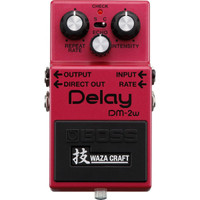 Boss DM-2WAnalog | Buffered | 2 sounds
Boss DM-2WAnalog | Buffered | 2 sounds
Boss DM-2W Analog | Buffered | 2 sounds
The Boss DM-2 and DM-3 analog delays are legendary for their exceptional sound. The DM-2W Waza Craft edition delivers a glorious, dark echo tone ideal for both recording and live performance, and it pairs beautifully with other delays and overdrive pedals. Expression pedal control adds further creative possibilities. ★★★★½
Read more: Boss DM-2W review
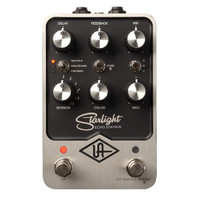 Electro-Harmonix CanyonDigital | Buffered | 11 sounds
Electro-Harmonix CanyonDigital | Buffered | 11 sounds
Electro-Harmonix Canyon Digital | Buffered | 11 sounds
The Electro-Harmonix Canyon offers a wide range of delay types, from tape echo to shimmer and octave delays, making it a versatile choice for players seeking diverse delay textures. While not as pristine as some studio-grade units, it’s inspiring and fun to use, fostering creativity. ★★★★½
Read more: Electro-Harmonix Canyon review
 Electro-Harmonix CanyonDigital | Buffered | 11 sounds
Electro-Harmonix CanyonDigital | Buffered | 11 sounds
Universal Audio Starlight Digital | True & buffered bypass | 9 sounds
The Universal Audio Starlight boasts a dual-processor design, authentically replicating the sound and response of legendary delay hardware, including a 60s Echoplex, a vintage Deluxe Memory Man, and pristine digital delays from Universal Audio’s heritage. ★★★★½
Read more: Universal Audio Starlight review
 Electro-Harmonix CanyonDigital | Buffered | 11 sounds
Electro-Harmonix CanyonDigital | Buffered | 11 sounds
TC Electronic Flashback 2 Mini Digital | Buffered | 8 sounds
The TC Electronic Flashback 2 Mini is a remarkably capable and compact delay pedal for its price. It delivers solid sounds with user-adjustable parameters, maintaining a warm, organic character across various delay types. ★★★★☆
Read more: TC Electronic Flashback 2 Mini review
Glossary
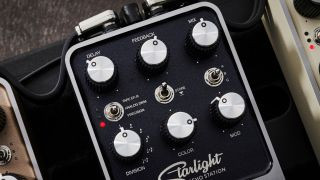 Universal Audio Starlight delay pedal controls closeup
Universal Audio Starlight delay pedal controls closeup
(Image credit: Future)
Confused by delay pedal terminology? This glossary clarifies key terms, from bucket brigade devices to buffered bypass.
Analog delay – Delay pedals using analog circuitry to create sounds by continuously varying electrical signals, often using bucket brigade devices.
Bucket brigade device (BBD) – A series of capacitors that slow down a signal as it passes through, creating delay.
Buffered bypass – A bypass circuit that strengthens the guitar signal, beneficial for long cable runs.
Digital delay – Delay pedals that convert the signal to digital, process it using algorithms, and convert it back to analog.
Feedback – The amount of delay repeats heard after playing a note.
Repeats – The number of delayed signals generated after the initial note. Also referred to as ‘time’ or ‘rate’.
Tap tempo – A feature allowing manual tempo setting by tapping a footswitch, useful for live performance.
Tape delay – Emulates vintage delays from analog tape machines, known for warmer, darker tones with compression and saturation.
Time – The interval between delay repeats. Also known as ‘repeats’ or ‘rate’.
Wow & flutter – Pitch modulation effects caused by imperfections in tape machines, with wow being low-frequency and flutter being higher-frequency modulation.
Analog or digital?
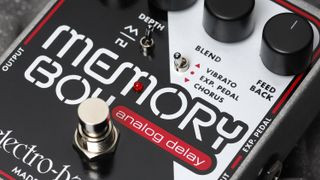 Electro-Harmonix Memory Boy analog delay pedal front view
Electro-Harmonix Memory Boy analog delay pedal front view
(Image credit: Future)
Delay pedals fall into two primary categories: analog and digital. Early delay units used tape, but analog pedals became prominent, utilizing bucket brigade chips to slow down the guitar signal. Analog delays are often described as warm and lo-fi, with the delayed signal degrading over repeats, creating a “warbley” character favored for its unique imperfections and potential for self-oscillation.
Digital delay pedals, conversely, can reproduce the guitar signal with pristine clarity and unlimited repeats. While some perceive this as sterile, it’s subjective and depends on musical context. Many modern digital delays effectively emulate analog and tape delay characteristics. High-end digital delays can convincingly replicate the nuances of vintage units, making it difficult to distinguish them from the “real thing.”
How to choose
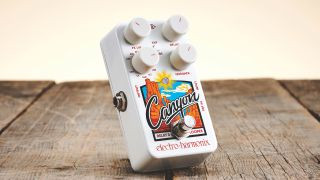 Electro Harmonix Canyon delay pedal angled view on wood table
Electro Harmonix Canyon delay pedal angled view on wood table
(Image credit: Future)
Choosing the best delay guitar pedal depends on your needs. For occasional use or simple experimentation, a single footswitch pedal with basic controls suffices.
However, players needing more versatility should consider feature-rich pedals with multiple footswitches for preset switching and tap tempo. Tap tempo is crucial for synchronizing delays with song tempos in live settings.
Pedals with numerous knobs offer extensive tonal customization, allowing adjustment of repeats, volume, tone, decay, and more. Consider the level of control you desire when selecting a delay pedal.
FAQs
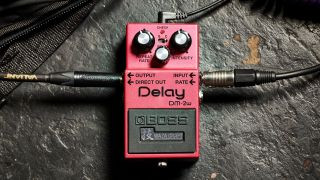 Boss DM-2w delay pedal on floor with cables
Boss DM-2w delay pedal on floor with cables
(Image credit: Future)
What does a delay pedal do?
A delay pedal records a copy of the played note and plays it back. Settings determine the nature of the repeat, from quick single echoes to long, sustained repetitions.
Where should I put my delay pedal?
Standard pedal order places delay after drive and modulation, but before reverb. Experimentation is encouraged, as placing delay before modulation or reverb can yield interesting results, especially in experimental music. Delay at the beginning of the chain can also create unconventional effects.
Why do I need a delay pedal?
While not strictly essential, delay enhances guitar tone by adding space and depth, particularly to lead guitar. Slapback delay can also thicken overall guitar tone.
How we test
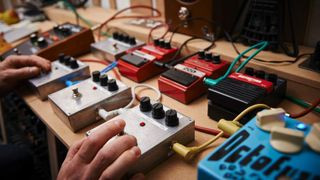 Guitar World testers with effects pedals
Guitar World testers with effects pedals
(Image credit: Future)
The Guitar World team consists of experienced musicians passionate about delay pedals. We use pedals from this guide in our rigs, drawing from live performance, studio recording, and sonic experimentation.
Our selection process emphasizes delay types, versatility, build quality, and contextual integration. We rigorously test pedals across diverse sonic settings, from ambient soundscapes to rock riffs. Our recommendations cater to both beginners and professionals, focusing on practical needs and sonic excellence.
Each recommendation stems from thorough testing and a commitment to providing valuable insights for guitarists seeking the perfect delay sound. Guitar World writers guide you through the world of delay pedals to achieve your desired musical expression.
Read more about how we test products and services.
